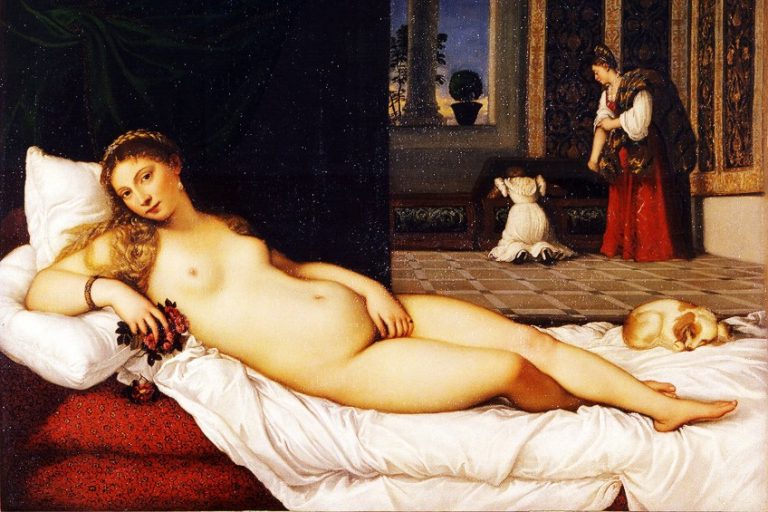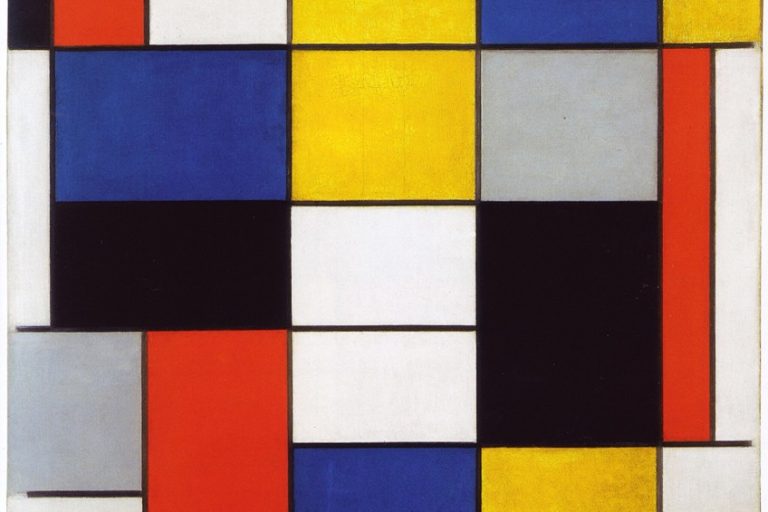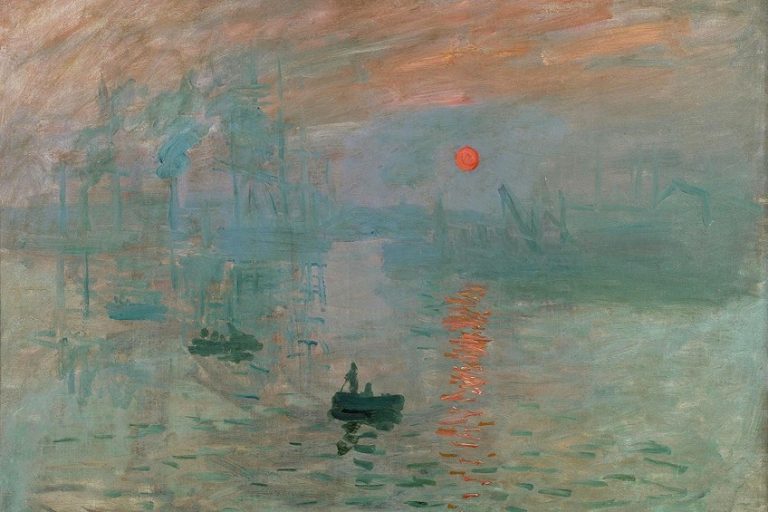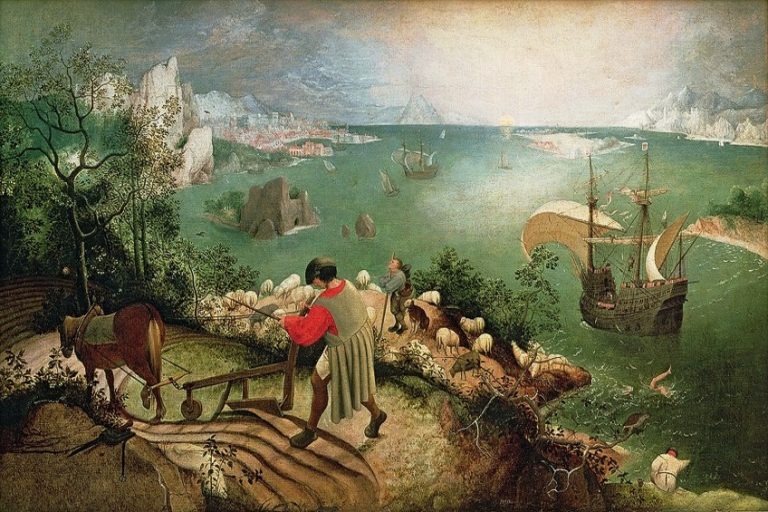Marc Chagall Paintings – Explore This Great Artist’s Oeuvre
Renowned Russian-French artist Marc Chagall was among the last of the first-generation Modernists in Europe, whose global influence was felt far and wide. A prominent figure who upheld Jewish tradition through Modernist frameworks, Chagall’s most fascinating works were his paintings, which offer insight into the many events that affected his mental state. In this article, we will introduce you to the 25 most famous Marc Chagall paintings that will stir your interest and help you reflect on the key moments of the past that shaped Modern art history.
Marc Chagall: Reflecting Heritage and Loss in Modern Art
Born in 1887, Marc Chagall was one of the world’s most famous and influential modern artists, who dabbled in multiple mediums while exploring themes that drew from his childhood experience in Vitebsk. In a century when one can draw many parallels to past historical events that shaped the artistic development of modern art for many 20th-century artists, including the education we receive today, one can still learn much from artists like Chagall.

So, what made his work so profound, and what themes did Chagall explore? Before we dive into our list of the 25 most famous Marc Chagall artworks, it is important to understand the background of the artist’s work, such that it will enlighten you on key ways that you can make sense of the world and your reality through art. Marc Chagall was an artist who created art that was informed primarily by his personal and lived experiences as a man born under Russian-French-Jewish heritage, and whose abundance of knowledge about his roots, modernist art, and bohemian culture.
Chagall traveled extensively and was acquainted with many famous artists, including many Cubists, Futurists, and modern artists who frequented Parisian art circles at the time.
Chagall studied in St. Petersburg under the direction of Léon Bakst, where he encountered Fauvism, including the works and styles of master Renaissance painters and post-Impressionists. His wife, Bella Rosenfeld, was a muse for Chagall throughout his life and he also believed that art was the gateway into one’s own mind and “psychic being”. Chagall was also a highly influential figure at the Ecole de Paris, with his works reflecting strong themes of nostalgia for his hometown, such that even André Breton commended the artist for returning metaphor to modern art. However, when the First World War hit, Chagall’s art had taken many significant turns in terms of reflecting the dark periods that followed, some of which you may notice in our list below.
Discover the 25 Most Famous Marc Chagall Paintings
Marc Chagall’s paintings were also once destroyed along with works by other prominent modernists such as Wassily Kandinsky and Paul Klee. This was largely due to the politics of German society at the time, which saw the terrorist Nazi regime embark on a twisted “purge” of art institutions, labeling artists who were considered “high profile” as makers of “degenerate art”. Chagall’s life was effectively at risk, beyond his art being targeted, he became a target of the Nazi oppressor for his Jewish descent. Below, we will dive into 25 iconic Marc Chagall artworks that provide valuable artistic insight into the artist’s experience.

I and the Village (1911)
| Date | 1911 |
| Medium | Oil on canvas |
| Dimensions (cm) | 192.1 x 151.4 |
| Where It Is Housed | Museum of Modern Art, New York City, United States |
Marc Chagall’s paintings reflected a sense of his encounters with Russian Mysticism while also exposing his experiences with new art styles of the modern era. This famous oil painting is housed at the Museum of Modern Art in New York and is representative of Chagall’s artistic exchange with the community known as La Ruche in Montparnasse. I and the Village is an ethereal reminder of Chagall’s mystic abstraction fused with folklore motifs inspired by his hometown in Belarus.
The painting’s title was derived from Chagall’s close friend, Blaise Cendrars, whose pun on the imagery of the eyes in the work served the artwork and its symbolism incredibly well.
Le Marchand de Bestiaux (1912)
| Date | 1912 |
| Medium | Oil on canvas |
| Dimensions (cm) | 97.1 x 202.5 |
| Where It Is Housed | Kunstmuseum Basel, Basel, Switzerland |
Le Marchand de Bestiaux is also recognized as The Cattle Dealer in English and was inspired by Chagall’s trips to a cattle market with his uncle. This simple scene of a cattle trader was used to evoke a universal reference to the force of life and its potency for renewal. The image of the foal in the belly of the mare that is pulling the cart is a powerful symbol of life, which is mirrored by the treatment of the young calf carried by the woman as a monument.
The painting was thus a metaphor and lesson in one composition, to affirm the potency of life and the gravity behind magnifying aspects of life, whether human or animal.
Paris Through the Window (1913)
| Date | 1913 |
| Medium | Oil on canvas |
| Dimensions (cm) | 136 x 141.9 |
| Where It Is Housed | Solomon R. Guggenheim Museum, New York City, United States |
Also known as Paris par la fenêtre in French, this famous Chagall painting was created in 1913, a few years after he moved from Russia to Paris. The painting is a clear reflection of Chagall’s exposure to Orphic Cubism, pioneered by the prolific artist Robert Delaunay, as indicated by the sheer overlapping color planes and the Eiffel Tower in the background.
Paintings such as this one remind us of how Chagall viewed his works, as lyrical evocations of his life rather than literal depictions of objects and places.
Over Vitebsk; Aux Environs de la Ville (1913)
| Date | 1913 |
| Medium | Oil, gouache, graphite, and ink on paper |
| Dimensions (cm) | 31.4 x 40 |
| Where It Is Housed | Philadelphia Museum of Art, Philadelphia, United States |
Over Vitebsk; Aux Environs de la Ville is an early painting by Chagall that was created after the artist returned to Vitebsk in 1914. The figure in the painting is an elderly beggar, who appears to float above the rooftops of the village during the winter. The composition draws similarities to a Yiddish expression for a beggar who moves from home to home.
Translated to er geyt iber di hayzer, this figure was portrayed in a fantastical manner with a sack slung over the figure’s back.
The Fiddler (1913)
| Date | 1913 |
| Medium | Oil on canvas |
| Dimensions (cm) | 188 x 158 |
| Where It Is Housed | Stedelijk Museum, Amsterdam, the Netherlands |
Completed in 1913 while Chagall was still in France, The Fiddler is recognized as one of the artist’s best paintings that represents the Hasidic culture of Jews who lived in Vitebsk that relied on music and dance to bring the community together and foster a sense of unity. The painting is also an excellent example of how Chagall merged the elements of Jewish and Christian tradition while employing vivid and almost Surrealist imagery, which later inspired the 1964 musical Fiddler on the Roof.
The painting’s style has been likened to a quasi-Cubist style that was reminiscent of both Russian and French art, a truly unique piece of art.
Self-Portrait With White Collar (1914)
| Date | 1914 |
| Medium | Oil on cardboard |
| Dimensions (cm) | 29.2 x 25.7 |
| Where It Is Housed | Philadelphia Museum of Art, Philadelphia, United States |
Self-Portrait With White Collar is among the best-known self-portraits of the artist that was made in Vitebsk, Chagall’s home, which was also later decimated. This is a more personal painting that reflects his relationship with his hometown and, when viewed in retrospect, is transformed into an honorific painting of Chagall’s culture and heritage.
In 1944, Chagall also lost his wife Bella and moved to France by 1947 since the United States was never much of a home to him.

Birthday (1915)
| Date | 1915 |
| Medium | Oil on cardboard |
| Dimensions (cm) | 81 x 99.7 |
| Where It Is Housed | Museum of Modern Art, New York City, United States |
Marc Chagall loved his wife Bella dearly and created this endearing painting in 1915, shortly before they married. An expression of love, Birthday was Chagall’s expression of his admiration and passion for his wife, to be close to her, and captures a moment of young love. Chagall’s style was dream-like and expressive in his choice of color to depict joy as his color palette offered insight into the meaning behind his life.
The artist himself once stated that the color of life was love, just as color exists on the artist’s palette to provide meaning.

The Blue House (1917)
| Date | 1917 |
| Medium | Oil on canvas |
| Dimensions (cm) | 66 x 96.8 |
| Where It Is Housed | Musée des Beaux-Arts de Liège, Liège, Belgium |
During Chagall’s two-month vacation in Vitebsk, he painted a series of landscape paintings such as the famous artwork The Blue House in 1917. Through his perceived impression and direct observation, Chagall produced a realistic depiction of the house, which upon close inspection, is composed of abstracted elements.
The painting demonstrates Chagall’s connection with Cubism, as applied in connection with Chagall’s observation of nature.
Cemetery Gate (1917)
| Date | 1917 |
| Medium | Oil on canvas |
| Dimensions (cm) | 87 x 68.6 |
| Where It Is Housed | Private collection |
Cemetery Gate reflects Chagall’s integration of political events into his paintings. This particular work was influenced by the Bolshevik revolution, which resulted in equal rights for Jewish people and newfound optimism for Chagall. The painting itself represents loss, grief, and sorrow with the inscription of a Hebrew prophecy from Ezekiel, which discusses themes of hope for those who have died.
Here, Chagall celebrated the end of the Czarist regime and his hope for the future of the country, cast in a Cubist painting style.
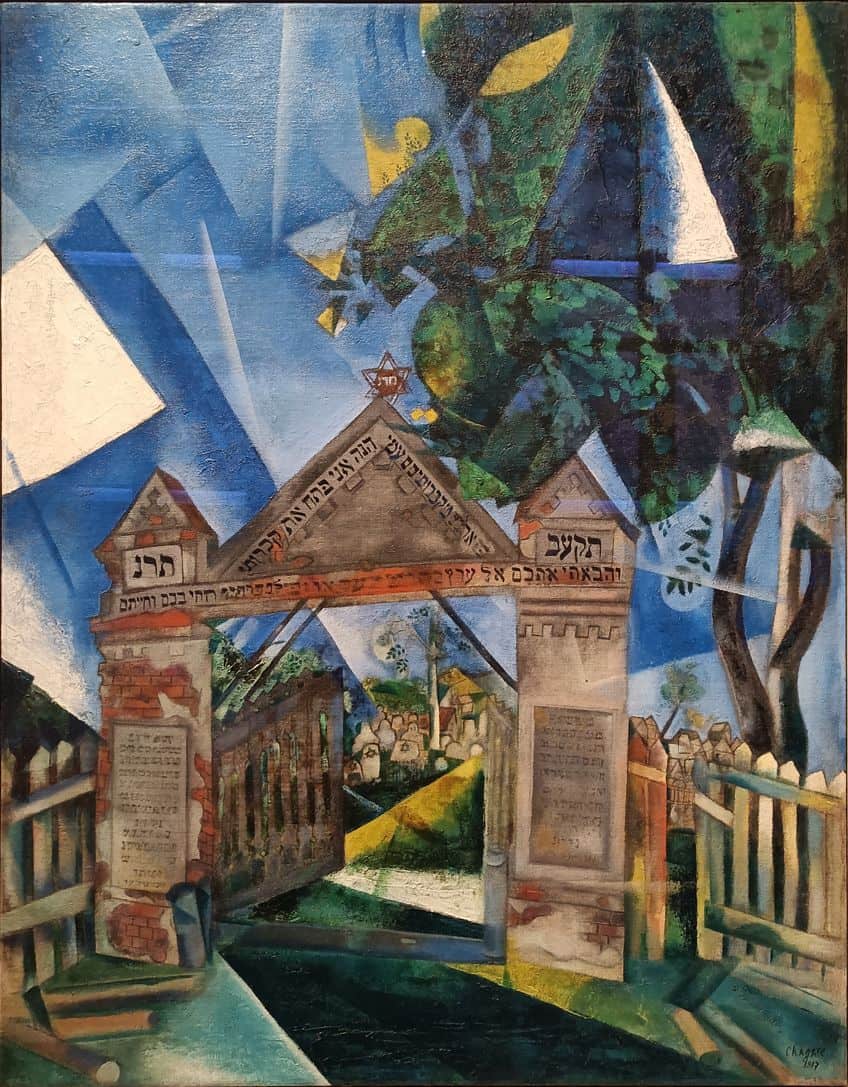
Promenade (1918)
| Date | 1918 |
| Medium | Oil on canvas |
| Dimensions (cm) | 170 x 163.5 |
| Where It Is Housed | Guggenheim Museum Bilbao, Bilbao, Spain |
Promenade is another famous Marc Chagall painting that was created in 1918 and features his signature use of flying and floating figures, alongside symbols of his Jewish heritage, animals, and Eastern European folklore. Works like Promenade had a profound influence on the 20th century since it was viewed as avant-garde and bridged the gaps between Symbolism, Cubism, and Fauvism.
He also exposed the artist’s experience with witnessing how the world wars impacted the lives of those around him and his own art career.
Equestrienne (1931)
| Date | 1931 |
| Medium | Oil on canvas |
| Dimensions (cm) | 100 x 80.8 |
| Where It Is Housed | Stedelijk Museum, Amsterdam, the Netherlands |
Equestrienne is among Chagall’s most unique and striking paintings that echo his exploration of the classical style to depict a circus scene. Chagall often painted circus scenes in the grotesque style, however, this painting evokes the themes of elegance and beauty, which have been captured in Chagall’s handling of color.
This also reflected his experience in his youth with French social culture and exposure to decorative art.
The Revolution (1937)
| Date | 1937 |
| Medium | Oil on canvas |
| Dimensions (cm) | 50 x 100 |
| Where It Is Housed | Private collection |
The Revolution is a direct response to Pablo Picasso’s rejection of Fascism through Guernica, which Chagall hoped to demonstrate in his own style and tone. The painting is an attempt to address political disquiet and includes symbols of Communism, as seen in the red flags, as well as a scene on the right, which represents the calls for political unity.
Art is often political in times of global strife, and this painting is a perfect example.
White Crucifixion (1938)
| Date | 1938 |
| Medium | Oil on canvas |
| Dimensions (cm) | 154.6 x 140 |
| Where It Is Housed | Art Institute Chicago, Illinois, United States |
White Crucifixion is a famous painting by Chagall that was created in 1938 and is one of the first paintings from the artist’s career that portrays the character of Jesus as a martyr to draw awareness to the atrocities that the Jews faced during the 1930s. Here, Chagall portrayed Christ as dressed in Jewish attire to highlight his religious beliefs while also using the story of Christ to draw parallels to the violent abuses and crimes against Jewish communities.
In this way, Chagall skillfully combined the modern events of his day with the religious iconography of Jesus as a martyr to represent the shared experience of his community in Europe and point out the crimes of oppressors such as those in the biblical narrative who persecuted and murdered Christ for his identity.
The Three Candles (c. 1938 – 1940)
| Date | c. 1938 – 1940 |
| Medium | Oil on canvas |
| Dimensions (cm) | 127.5 x 96.5 |
| Where It Is Housed | Private collection |
The Three Candles is among the most famous paintings by Marc Chagall that was created sometime between 1938 and 1940. The political context of the painting revolves around the German invasion of Poland and France and the start of World War Two. For Chagall, his presence in the occupied territories meant that his life was at high risk, causing him to flee to the south of France with his family and art. Chagall was also captured by the authorities at one point and then released after pressure from America.
The Three Candles encompasses a sense of unease, which Chagall was deeply familiar with throughout this period.
The Dream (1939)
| Date | 1939 |
| Medium | Watercolor and pastel on paper |
| Dimensions (cm) | 52.2 x 67.9 |
| Where It Is Housed | The Phillips Collection, Washington D.C., United States |
Considered a classic representation of Chagall’s approach to figurative paintings and his consistent theme of lovers, here, Chagall presented a message of hope, conceived presumably in a dream. His sources of inspiration are believed to stem from village life, young love, Medieval culture, as well as Russian folkloric and Hasidic Jewish culture. In the same year as the painting was created, Chagall and his family were forced to move to the French countryside.
Themes of village life as a motif emerged quite strongly in his work.
Midsummer Night’s Dream (1939)
| Date | 1939 |
| Medium | Oil on canvas |
| Dimensions (cm) | 117.1 x 88.6 |
| Where It Is Housed | Musée de Grenoble, Grenoble, France |
Despite spending most of his life in Europe, Chagall longed for his home in Russia. Midsummer Night’s Dream is a manifestation of the artist’s encounter with William Shakespeare’s play Midsummer Night’s Dream during his time in Paris, which inspired Chagall to capture the character Titania and her donkey-headed lover in a forest.
The figures are among winged creatures and musical elements, both motifs of which appear frequently in Chagall’s paintings.
Cow with Parasol (1946)
| Date | 1946 |
| Medium | Oil on canvas |
| Dimensions (cm) | 81.3 x 108 |
| Where It Is Housed | The Metropolitan Museum of Art, New York City, United States |
This famous Marc Chagall painting has strong associations with a dark period in his life when the artist experienced the death of his wife, who died from a viral illness in 1944. After living together for 29 years, Chagall took the loss of his wife quite heavily, leading to him putting down the paintbrush for many months to process his grief. Cow with Parasol evokes the artist’s intense imagination using a substituted figure of a cow in place of the traditional use of a human to convey the irony of the work. Through humor and slight joy, Chagall’s grief is unpacked, which can still be felt in his use of grim colors.
Cow with Parasol was simultaneously a revival of his career and desire to paint again after he returned to Europe and met Virginia Haggard McNeill.
La Chute de L’Angle (1947)
| Date | 1947 |
| Medium | Oil on canvas |
| Dimensions (cm) | 148 x 189 |
| Where It Is Housed | Private collection |
La Chute de L’Angle reflects the melancholic stages of Chagall’s painting career that was impacted by the atrocities of the two world wars. La Chute de L’Angle took Chagall almost 25 years to complete and includes motifs such as angels and themes of Christian redemption alongside his traditional visions.
This work encompasses his observations up until this point in his life in the late 1940s and is much darker in color palette than his hopeful and joyous works.
La Mariée (1950)
| Date | 1950 |
| Medium | Gouache and pastel |
| Dimensions (cm) | 68 x 53 |
| Where It Is Housed | Private collection in Japan |
Famously featured in the 1999 film Notting Hill, this iconic painting by Marc Chagall was created in 1950 and translates in English to The Bride. The famous painting portrays a bride holding a bouquet and being presented to the viewer. The eye-catching colors used by Chagall are what make this painting so unique since the vivid red of the bride’s dress stands out in contrast to the deep blue hues of the background.
The painting is thought to symbolize the sense of yearning for a lost love.
The Concert (1957)
| Date | 1957 |
| Medium | Oil on canvas |
| Dimensions (cm) | 140 x 239.5 |
| Where It Is Housed | Private collection |
Created in 1957, The Concert is one of Chagall’s most harmonic paintings that combines the elements of line, shape, and color with biblical references to aspects of human life such as love, education, and school. Here, he also depicted symbols such as the Eiffel Tower, winged creatures, and musical elements, reminding one of the artist’s move from Paris, who like many artists, had to seek refuge in other areas.
The Côte d’Azur became Chagall’s Montparnasse, where he built his own studio.
War (1964)
| Date | 1964 |
| Medium | Oil on canvas |
| Dimensions (cm) | 163 x 231 |
| Where It Is Housed | Kunsthaus Zürich, Zürich, Switzerland |
Relevant themes of exile, escape, and wartime tragedy appear in this famous Marc Chagall painting, which portrays the suffering of people during the war. The painting also features a crucifixion scene, which highlights the martyrs of those caught in war. The scene might contain many symbolic references to the 20th century atrocities of World War One and Two.
This stirs up identical emotions and experiences to those who are the victims of conflict today.
Peace Window (1964)
| Date | 1964 |
| Medium | Stained glass |
| Dimensions (cm) | 370 x 460 |
| Where It Is Housed | United Nations Secretariat Building, New York City, United States |
This famous stained-glass painting was created by Chagall in 1964 and is currently housed at the United Nations Secretariat Building in New York. The artwork entitled Peace Window is a tribute to the United Nations’ second secretary-general Dag Hammarskjöld, who died in a plane accident in Africa. The artwork was inspired by an excerpt from the biblical chapter of Isaiah that discusses themes of unity and joy.
Here, Chagall presented man’s search for harmony and peace using the symbols of the prophet Isaiah and the image of a mother and child, cast in blue hues and highlights of green and yellow.
The Sun of Poros (1968)
| Date | 1968 |
| Medium | Oil on canvas |
| Dimensions (cm) | 160 x 160 |
| Where It Is Housed | Private collection |
The Sun of Poros was inspired by Chagall’s experience of the Greek island of Poros in 1952, where a publisher known as Teriade, invited Chagall to reside with him in Poros. Teriade inherited the artworks that Chagall had previously made for Vollard, illustrating the romance between Daphnis and Chloe. Teriade requested that Chagall produce a Greek background for the illustrations and thus sent him an invite. At the time, Chagall was about to visit Palestine before creating the etchings, however, he also wished to become familiar with a new environment and chose to visit Greece, stopping at Athens and Delphi. It was during the trip that Chagall identified the influence of the Greek world on Western culture.
He later returned to similar antique themes for his set design contributions to Ravel’s ballet Daphnis and Chloe in the late 1950s.
America Windows (1977)
| Date | 1977 |
| Medium | Stained glass |
| Dimensions (cm) | 244 x 978 |
| Where It Is Housed | Art Institute Chicago, Illinois, United States |
America Windows is a widely-recognized stained glass painting by Marc Chagall, created in 1977 in celebration of the US Bicentennial. Although the work is more of a historical homage to the history of the United States, it was executed in Chagall’s unique style, depicting the skyscrapers of Chicago and elements of American culture.
This includes all arts, from theater and dance to painting and music.

Le Couple Aux Deux Bouquets (1982)
| Date | 1982 |
| Medium | Oil on canvas |
| Dimensions (cm) | 100.3 x 73 |
| Where It Is Housed | Private collection |
Painted in 1982, this colorful painting depicts two figures, believed to be a romantic couple, in an embrace as they float above Paris, with their vibrant energies of love and compassion shining as bright as the floral arrangements beside them. Le Couple Aux Deux Bouquets is a fascinating painting that sold for $2.5 million on auction at Christie’s in 2021 since it was created at the artist’s most prolific moment in his career. The composition also reflects Chagall’s exploration of lovers and flowers in paintings that he explored as early as the 1920s.
These 25 famous paintings by Marc Chagall offer a wealth of insight into the lived reality of the French-Russian artist and his life-long exploration of his culture, heritage, and autobiographical account of wartime trauma. In reviewing the works of prominent 20th-century painters such as Chagall, we can perhaps discover alternative ways of representing our personal truths while responding to our environment.
Frequently Asked Questions
Who Was Marc Chagall?
Globally renowned painter Marc Chagall was a famous Russian-French artist, who was widely recognized for his contributions to multiple avant-garde art movements in the 20th century. Chagall produced artworks using multiple mediums that ranged from painting to set design.
What Is the Most Famous Painting by Marc Chagall?
I and the Village (1911) is considered to be the most famous painting by Marc Chagall. The painting was created in a Cubist style and features the artist’s signature use of dreamlike elements. I and the Village is also recognized alongside his other famous paintings like Paris Through the Window (1913) and Birthday (1915).
What Painting Style Did Marc Chagall Use?
Marc Chagall experimented with a diverse range of painting styles and often worked with a fusion of Cubist, Fauvist, and Surrealist styles. Chagall’s work is largely identified with modernist painting.
Jordan Anthony is a film photographer, curator, and arts writer based in Cape Town, South Africa. Anthony schooled in Durban and graduated from the University of the Witwatersrand, Johannesburg, with a Bachelor of Art in Fine Arts. During her studies, she explored additional electives in archaeology and psychology, while focusing on themes such as healing, identity, dreams, and intuitive creation in her Contemporary art practice. She has since worked and collaborated with various professionals in the local art industry, including the KZNSA Gallery in Durban (with Strauss & Co.), Turbine Art Fair (via overheard in the gallery), and the Wits Art Museum.
Anthony’s interests include subjects and themes related to philosophy, memory, and esotericism. Her personal photography archive traces her exploration of film through abstract manipulations of color, portraiture, candid photography, and urban landscapes. Her favorite art movements include Surrealism and Fluxus, as well as art produced by ancient civilizations. Anthony’s earliest encounters with art began in childhood with a book on Salvador Dalí and imagery from old recipe books, medical books, and religious literature. She also enjoys the allure of found objects, brown noise, and constellations.
Learn more about Jordan Anthony and the Art in Context Team.
Cite this Article
Jordan, Anthony, “Marc Chagall Paintings – Explore This Great Artist’s Oeuvre.” Art in Context. January 10, 2024. URL: https://artincontext.org/marc-chagall-paintings/
Anthony, J. (2024, 10 January). Marc Chagall Paintings – Explore This Great Artist’s Oeuvre. Art in Context. https://artincontext.org/marc-chagall-paintings/
Anthony, Jordan. “Marc Chagall Paintings – Explore This Great Artist’s Oeuvre.” Art in Context, January 10, 2024. https://artincontext.org/marc-chagall-paintings/.





